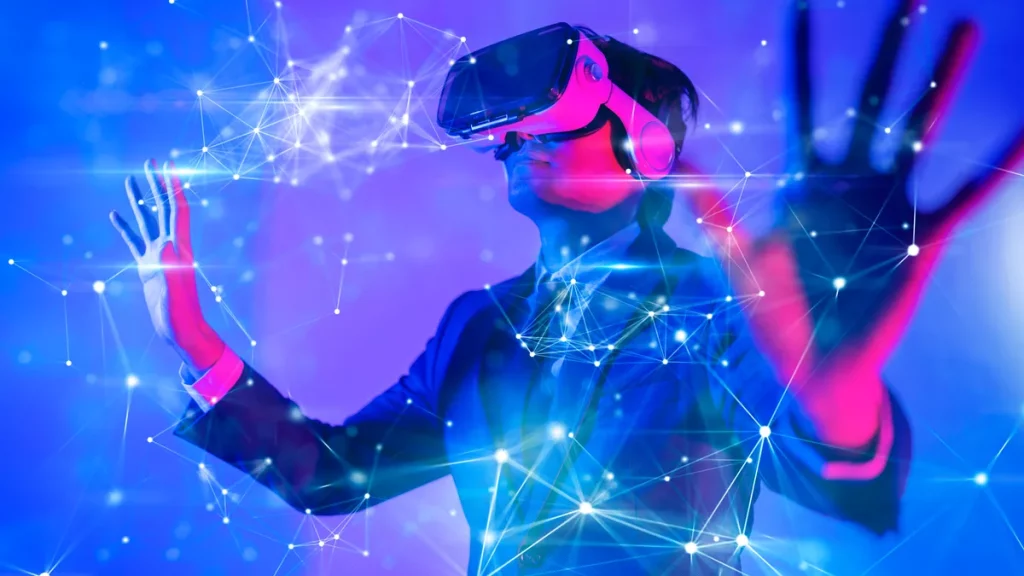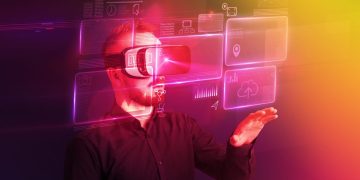The concept of the metaverse has moved from science fiction to a rapidly developing reality. What once seemed like a distant dream, popularized by novels like Ready Player One, has increasingly become a topic of discussion among tech giants, developers, and consumers alike. The metaverse is poised to revolutionize how we interact with the digital world, blending virtual, augmented, and physical realities into an integrated and immersive experience.
But what exactly is the metaverse, and how will it shape the future of digital interactions? This article provides a comprehensive look at the evolving metaverse, its potential applications, and the hurdles it must overcome to become a transformative part of our digital lives.
1. Understanding the Metaverse: A Digital Universe Beyond Boundaries
The metaverse is essentially a collective virtual space where people can interact with each other, digital environments, and even AI-generated entities, all in real time. It’s an interconnected network of virtual worlds, augmented reality (AR), virtual reality (VR), and digital experiences that exist simultaneously across different platforms. In the metaverse, users are represented by avatars and can engage in a variety of activities, ranging from work and entertainment to socializing and gaming.
While the idea of virtual reality has existed for decades, the metaverse extends far beyond immersive gaming experiences or simple VR interactions. It integrates multiple aspects of online life—social media, shopping, entertainment, work, and education—into one interconnected digital ecosystem.
2. Key Technologies Powering the Metaverse
Several cutting-edge technologies are driving the evolution of the metaverse, enabling richer and more interactive experiences. Some of these key technologies include:
Virtual Reality (VR):
VR headsets and immersive experiences allow users to fully engage with digital environments. These technologies are already being used for gaming, simulations, and even remote collaboration. As VR technology continues to improve, it will play a critical role in enabling seamless entry into the metaverse.
Augmented Reality (AR):
AR overlays digital elements on top of the physical world, creating a hybrid experience where virtual and real-world objects coexist. Devices like AR glasses and smartphones are already bringing AR into various industries such as retail, real estate, and education. In the metaverse, AR has the potential to enhance real-world experiences by integrating virtual elements into daily life.
Blockchain and Cryptocurrencies:
Blockchain technology provides the foundation for a decentralized metaverse, where users can own virtual assets securely. Blockchain ensures transparency and ownership by verifying the authenticity of digital goods, including virtual real estate, collectibles, and NFTs (Non-Fungible Tokens). Cryptocurrencies like Bitcoin and Ethereum are also integral to metaverse economies, enabling transactions without relying on traditional financial systems.
Artificial Intelligence (AI):
AI algorithms enhance the metaverse by enabling intelligent NPCs (non-playable characters), personalized user experiences, and real-time data analysis. AI can also power virtual assistants, chatbots, and smart avatars that help users navigate virtual worlds and interact with digital environments more naturally.
5G and Edge Computing:
The high-speed data transfer provided by 5G networks is crucial for real-time interactions in the metaverse. To deliver smooth, low-latency experiences, edge computing will also play a significant role by processing data closer to the user’s device, reducing the time it takes to render and transmit virtual content.

3. The Expanding Applications of the Metaverse
As the metaverse continues to grow, it is expected to touch nearly every aspect of our lives. Here are some key areas where the metaverse is already making an impact—and where it is poised to further shape the future:
Virtual Socialization:
Social media has already revolutionized how we connect with people around the world, but the metaverse takes this concept to the next level. Instead of just posting updates or commenting on photos, users will be able to attend virtual events, hang out in digital environments, and communicate with friends through avatars in real time. Platforms like Facebook Horizon and AltspaceVR are already experimenting with this type of virtual interaction.
In the metaverse, digital socialization will be more immersive and interactive, with people able to meet in virtual spaces, collaborate on projects, attend concerts or conferences, or simply unwind together. As avatars become more lifelike and personalized, these virtual interactions will feel more authentic and engaging.
Virtual Commerce:
The rise of e-commerce has already transformed how people shop, but in the metaverse, shopping experiences will become even more immersive. Users will be able to browse virtual stores, try on clothes with digital avatars, and buy virtual goods using cryptocurrencies or in-platform currencies. Companies like Nike and Gucci are already exploring the concept of virtual storefronts and selling digital products within virtual worlds.
Additionally, the metaverse allows for the creation of virtual real estate and spaces that can be rented or sold. Users may be able to design and own their virtual homes, stores, or meeting places within these environments.
Gaming and Entertainment:
The gaming industry is already heavily invested in the metaverse concept, with MMORPGs (Massively Multiplayer Online Role-Playing Games) like Fortnite and Roblox acting as early precursors to the virtual worlds of the future. Players can interact, socialize, and experience shared environments in real time, blurring the lines between games and social platforms.
Beyond gaming, the metaverse will open up new avenues for entertainment. Concerts, theatrical performances, and movie screenings could take place in virtual venues, where users can experience live events with friends from all over the world. Platforms such as Decentraland and Somnium Space are already experimenting with this idea by hosting virtual events and performances.
Work and Education:
One of the most significant shifts that the metaverse promises is its impact on remote work and education. The pandemic has already shown the potential for digital collaboration, but the metaverse has the ability to take it even further. In virtual office environments, employees can collaborate in real-time, attend meetings, and work alongside colleagues from around the world using avatars and immersive environments.
Similarly, the metaverse could revolutionize education by providing students with interactive and experiential learning opportunities. Instead of just attending lectures or viewing videos, students could engage in hands-on learning in virtual labs, participate in global classrooms, or even explore historical events in fully immersive virtual field trips.
Healthcare:
The metaverse also has transformative potential in healthcare, from training medical professionals to providing new opportunities for remote patient care. Virtual reality simulations are already being used for medical training and surgical planning, allowing healthcare providers to practice and refine their skills in a risk-free environment.
In addition, the metaverse could allow for more interactive and personalized healthcare experiences, enabling virtual consultations with doctors, mental health therapy sessions, and remote rehabilitation exercises.
4. Challenges and Obstacles Facing the Metaverse
While the potential of the metaverse is vast, several challenges must be addressed before it can achieve mainstream adoption.
Privacy and Security:
One of the most significant concerns with the metaverse is privacy. As users interact in virtual worlds, they will generate massive amounts of personal data, including behavioral patterns, preferences, and even biometric data. Protecting this information and ensuring users have control over their digital identities is a critical issue that needs to be addressed.
Additionally, cybersecurity becomes even more vital in the metaverse, especially as virtual environments become more integrated with real-world finances. The risk of cyberattacks, hacking, and fraud increases as virtual currencies and assets become more valuable.
Accessibility and Inclusivity:
For the metaverse to succeed, it must be accessible to people from all backgrounds, including those with physical disabilities or technological limitations. As it is currently being developed, the metaverse is often designed with high-end gaming PCs and VR headsets in mind, which can be expensive and inaccessible to many users.
Ensuring that the metaverse is inclusive and can accommodate a wide range of users—regardless of their financial means, geographical location, or physical abilities—will be essential for its long-term success.
Ethical and Regulatory Issues:
As the metaverse continues to evolve, ethical concerns surrounding its use will also become more prominent. Issues such as digital addiction, virtual harassment, and the potential for exploitation must be addressed. Developers, policymakers, and users will need to work together to establish clear ethical guidelines and regulations for virtual spaces.
5. The Future of the Metaverse
The metaverse is on the brink of transformation, but there is still much to be done. As technologies continue to advance and the infrastructure for a truly immersive digital world takes shape, the potential for virtual realities to shape digital interactions is immense. The metaverse promises to reshape everything from how we socialize and work to how we shop, learn, and play.
While significant challenges remain, the possibilities are vast. By addressing privacy, accessibility, and ethical concerns, the metaverse could usher in a new era of digital interaction that is more interconnected, immersive, and inclusive than ever before.


















































Discussion about this post